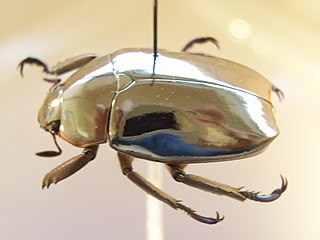
The ruteline genus Chrysina, or jewel scarabs, is a large genus of brightly colored, often metallic iridescent species, ranging from the southwestern edge of the United States as far south as Venezuela and Ecuador. The genus includes all the species formerly known as Plusiotis. They are typically between 15–35 millimetres (0.59–1.38 in) in length, and are nocturnal in habits, coming readily to lights. The larvae live in rotting logs, while the adults commonly feed on foliage; they tend to be found in pine, juniper, or pine-oak forests, most commonly between 1,000–3,000 metres (3,300–9,800 ft) elevation. They are most diverse in countries such as Guatemala, where as many as 15 species can be found in a single location, but there are only 4 species which occur in the United States.

Autoba is a genus of moths of the family Erebidae. The genus was erected by Francis Walker in 1863.

Chrysina gloriosa is a species of scarab whose common names are glorious beetle and glorious scarab. The adults are 25 to 28 millimetres long and are bright green with silver stripes on the elytra. These iridescent stripes on the cuticle of the elytra are a result of cholesteric liquid crystal organization of chitin molecules. The differences in color are a result of the microscopic structure of each section, with green reflected from cusp-like structures and silver reflected from flat layers parallel to the surface of the elytra. As established through Mueller matrix spectroscopic ellipsometry, the optical properties change with the incidence angle of the propagating light. The polygonal cells in the green stripes generate self-healing Bessel beams. The adults eat juniper leaves at a high elevation and are able to camouflage by blending in with plants. The species is sometimes incorrectly thought to be endangered, but has never been listed either in the IUCN Red List of Threatened Species or under the United States Endangered Species Act. An invalid synonym used to be Plusiotis gloriosa.

Chrysina resplendens is a scarab beetle found in Costa Rica, Panama, El Salvador and other countries in Central America.

Rutelinae or shining leaf chafers is a subfamily of the scarab beetles. It is a very diverse group; distributed over most of the world, it contains some 200 genera with over 4,000 described species in 7 tribes. A few recent classifications include the tribe Hopliini, but this is not generally accepted.
Marc Soula was a French entomologist. He was born in Oran and died in Lima (Peru).
Eusapromyza is a genus of small flies of the family Lauxaniidae.
Cotinis beraudi is a species of Cotinis scarab.

Chrysina aurigans is a species of scarab beetle found in Costa Rica. It is notable for its golden color.
Chrysina boucardi is a species of scarab beetle found in Costa Rica.
Rutelini is a tribe of shining leaf chafers in the family Scarabaeidae. There are about 14 genera and at least 40 described species in Rutelini.
Chrysina lecontei, or Leconte's chrysina, is a species of shining leaf chafer in the family of beetles known as Scarabaeidae.

Wolfgang Lubitz is a German chemist and biophysicist. He is currently a director emeritus at the Max Planck Institute for Chemical Energy Conversion. He is well known for his work on bacterial photosynthetic reaction centres, hydrogenase enzymes, and the oxygen-evolving complex using a variety of biophysical techniques. He has been recognized by a Festschrift for his contributions to electron paramagnetic resonance (EPR) and its applications to chemical and biological systems.

Chrysina adolphi is a species of ruteline scarab beetle from central America. They are found in the Sierra Madre del Sur in the Mexican states of Guerrero and Oaxaca where they feed on the leaves of Quercus species. Adults emerge from July to September.






